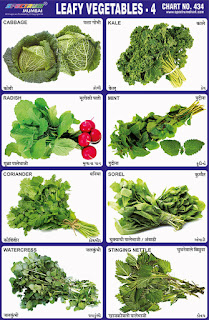 |
| Leafy Vegetables 4 Chart |
Spectrum Chart - 434 : Leafy Vegetables 4
1. Cabbage - Cabbage is very popular
vegetable that belongs to the family Brassicaceae. Cabbage is
prepared and consumed in many ways. The simplest options include
eating the vegetable raw or steamingit, though many cuisines pickle,
stew, sautee or braise cabbage. Cabbage is rich source of vitamins C,
K, B6 and B9 and minerals such as manganese and
calcium.
2. Kale - Kale is a very versatile and
nutritious green leafy vegetable. It is a widely popular
leafy-vegetable since ancient Greek and Roman times cultivated for
its low fat, no cholesterol but health benefiting, anti-oxidant rich
leaves. Fresh, young, tender crispy borecole can be used raw in
salads.
3. Radish - Radish has green, strap-like
or lobed leaves arranged in the form of rosette. Radish leaves can be
consumed fresh, as salad, but they are less popular than root. Radish
is rich source of vitamin C and vitamins of the B group.
4. Mint - Mint is herbaceous plant that
belongs to the family Lamiaceae. Mint is widely used in the
confectionery industry for the production of cookies, chocolates,
candies and chewing gums. Essential oils and menthol extracted from
the mint leaves are used in the manufacture of toothpaste and
mouthwashes.
5. Coriander - Coriander, commonly known
as Dhania in the Indian Subcontinent is an herb that is extensively
used around the world as a condiment, garnish or decoration on
culinary dishes. Leaves of coriander have fresh, grassy, lemony
taste, while seed have sweet, nutty, warm and orange-like flavour.
Coriander is rich source of dietary fibres, vitamins K, A and C and
minerals such as magnesium, iron and potassium.
6. Sorrel - Sorrel is a type of herbaceous
plant that belongs to the buckwheat family. Leaves, seed and root of
common sorrel are used in human diet. They can be consumed in the
form of salads, soups and stews. Sorrel can be also consumed in the
form of tea or lemonade-like drink. Sorrel is rich source of dietary
fibers, vitamins A and C and minerals such as iron, magnesium and
potassium.
7. Watercress - Watercress is a rapidly
growing, aquatic or semi-aquatic, perennial plant native to Europe
and Asia and one of the oldest known leaf vegetables consumed by
humans. It contains significant amounts of vitamin K, vitamin A,
vitamin C, riboflavin, vitamin B6, calcium, manganese and
folate.
8. Stinging Nettle - Stinging nettle is a
herbaceous perennial flowering plant in the family Urticaceae. The
plant has a long history of use as a source of medicine, food and
fibre. It has a flavour similar to spinach mixed with cucumber when
cooked and is rich in vitamins A and C, iron, potassium, manganese
and calcium.

No comments:
Post a Comment